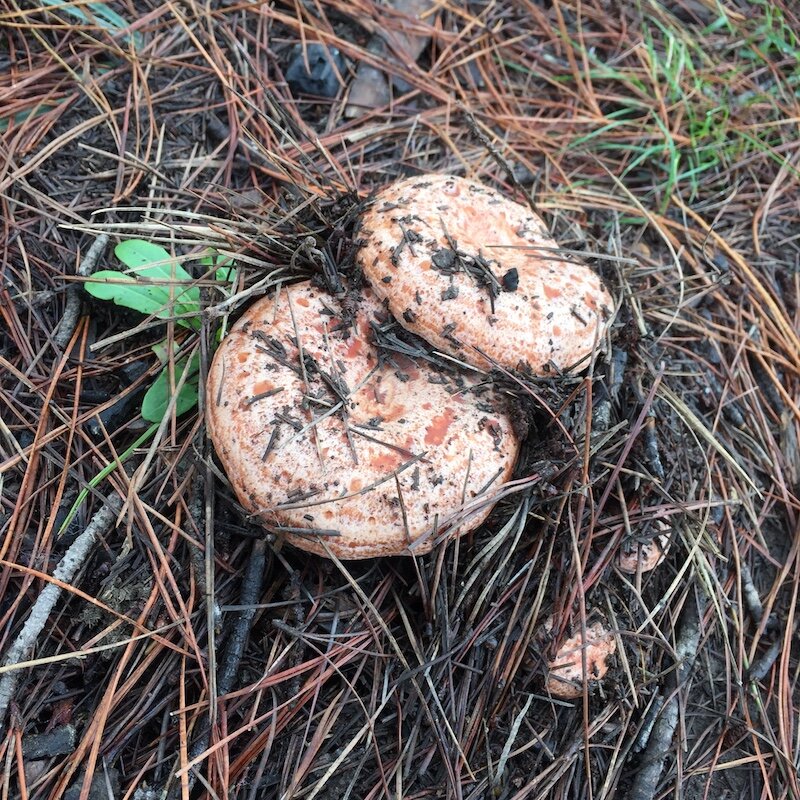Pine mushrooms: the what, where and how of harvesting Saffron Milk Caps in Australia
What we term pine mushrooms these days -the edible seasonal treat that people harvest from pine plantations on the East Coast of Australia- come with a story that has migrant roots, and more specifically Polish, Italian and to lesser extent Russian and Eastern European.
The story goes that at some point earlier last century, the spores of edible mushrooms made it to the pine forests of Australia. Some say the forests were deliberately inoculated, others say the fungi came attached to the roots of early tree imports, others even say that Forestry Corporations (the managers of pine plantations in Australia) introduced the mycelia of a number of beneficial mushrooms in the pines so to enable the trees to thrive and grow faster.
Whatever the story, the migrant community of Australia knew straight away what they were and what to do with these introduced mushrooms. Eat them!
Looking for a workshop to learn how to harvest edible pine mushrooms in NSW?
And so now, something that has been so culturally guarded right up to the last generation of Mediterranean And Eastern European migrants suddenly explodes into edible adventures, an alternative economy for regional people and a seasonal treat on the kitchen tables of some of the fanciest restaurants in the country, see here, here and here>
If you are of Polish or Italian descent, chances are, you would have spent your Easter holidays in the forest. Learning language and recipes, connecting with family and place, celebrating culture and ties to cultural knowledge. The activity fostered a sense of belonging and legitimacy, in a foreign country, speaking a foreign language, amongst a forest of exotic trees. This cultural landscape and what it does in shaping our understanding of place and belonging has been explored by many.
Image by Mogus
Here, for example, is a short article from Anath Gopal, a Human Geographer from Wollongong University who came to my Mushroom Foraging workshops and expressed, in such beautiful words complex narratives of interspecies relationships: how harvesting mushrooms can shape the way we see the world.
Or the beautiful essay by Max Kwiatkowski that talks about ethnoscape, a term that loosely wants to define a point of connection between cultural narratives and ecology. You can read it in full here. Fascinating and revealing.
In my opinion, these ‘spaces of connection’ need to be fostered, celebrated and protected. Via connection, we can cultivate care.
By now the secret is out and organised workshops see people heading out into the forest every season to learn about this bounty. Forestry corporations now acknowledge the practice and legislate it (with licences for people who want to harvest commercially) and councils even set up festivals, taking advantage of the influx of mushroom tourism that happens every year between March and June.
OK, here it is, below a rundown of what to look for.
Identification:
Important: There is only one way to know if what you are looking at is the mushroom that you think it is, and that is systematically going through ALL of the identification features and tick each box. If any of the features is dubious, you leave the mushroom alone. ‘Kind-of’ or ‘close-enough’ assessments are a sure way to make mistakes. You HAVE to be pedantic. Sometimes there are variables, some mushrooms are slightly different, not perfect and odd, but until you are perfectly confident and experienced with the species, you leave the odd ones alone, or get them checked by someone who knows.
PLEASE NOTE: It is always best to go out with some expert forager at first, learn the ropes of the hunt, and confirm your identification skills.
Saffron milk caps/Pine mushroom identification features are:
COLOUR: the mushroom is orange-red when young, fading when older. The flesh is white-cream in colour with distinctive bright orange milk oozing out when broken.
SHAPE OF CAP: Starts off as a button to then grow a trumpet-like cap. The shape is highly variable and irregular, with a dip in the centre. The mushroom grows to dinner plate size in favourable conditions.
DISTINCTIVE MARKS: the cap has visible concentric circles on the top created by lighter and darker shades of orange. The whole mushroom is speckled with reddish-orange markings and pitted as if bombarded by meteors.
STALK: the stalk (stipe) is stout, about 2-5cm long, 2-5cm wide and hollow. The stalk tapers to a small point at the base.
GILLS: in the underside, there are thin membranes radiating from the stalk, they are a consistent orange, easily bruised and turning green-blue.
SPORES: they are cream in colour broadly ellipsoid and of average size 8.5 x 6.5 microns
BRUISING: it quickly changes to green-blue where bruised.
LOCATION: Exclusively pine trees
Short, stubby stalk, orange all over, shaped like a trumpet
Start off like a button, It has a dotted surface.
Orange gills, bright orange milk, concentric circles marking on cap.
Pine mushrooms grow exclusively by pine trees.
Location: the key to the correct identification of mushrooms is the location where they grow.
To put it simply, if you are not near a pine tree, then it is not a Saffron Milk Cap (pine mushroom). They call it a pine mushroom for a reason, and by pine, I do not mean Norfolk Island pines, or Bunya pine, or casuarinas. It HAS to be a true pine.
Distribution:
Saffron milk caps are found on the South East of Australia, from northern NSW to South Australia, see map. They grow wherever there are pines but they are most commonly collected from pine plantations, see Forestry NSW or HVP in Victoria.
How to harvest mushrooms and look after ecologies.
Pine mushrooms are not free food, they are a gift. Please treat them as such. Treat the forest as the precious ecosystem that it is, whether it is a plantation or not. Take away your rubbish and stick to tracks with your transport. When you look after these amazing ecosystems, you will be richly rewarded. A happy pine forest is a generous one.
Only ever pick what you will use that day or preserve that night.
How to cook pine mushrooms
There are so many recipes, from mushroom Schnitzel, soups and dips to mushroom pies.
Generally speaking, Saffron milk caps are quite firm, meaty mushrooms, they are slightly peppery and flavoursome. A classic recipe is sliced and fried in a pan with oil and a little garlic, to then serve hot with a sprinkle of parsley.
Below I share a recipe that my wife and I serve to friends and at our events.
Pine mushroom & Sorrel risotto
Ingredients
4 cups of good quality vegetable liquid stock
1 tbsp olive oil
1 medium brown onion, finely chopped
1 garlic clove, crushed
1 1/2 cups arborio rice
1/2 cup dry white wine
1 cup of sliced, fresh or pickled pine mushrooms
1 cup of rambling dock or common sorrel
shaved parmesan cheese, to serve -optional
Method
1. Heat oil in a large, heavy-based saucepan over medium-high heat. Add brown onion and sliced Pine mushrooms. Cook, stirring, for 5 minutes or until softened. Add garlic and rice. Cook, stirring, for 1 minute. Add wine. Bring to the boil. Cook, stirring, for 3 minutes or until liquid has almost evaporated. Reduce heat to low.
Add 1 ladle stock mixture to rice. Cook, stirring until the liquid has absorbed. Repeat with the remaining stock mixture, 1 ladle at a time.
2. Stir in Sorrel. Stand for 2 minutes.
3. Serve with shaved parmesan and garnish with fresh sorrel and enjoy the hearty winter deliciousness.
How to preserve them:
There are several ways to preserve this seasonal bounty. You can fry in a pan and then freeze in small parcels. You can make a soup, reduce it ‘till it is quite thick and then freeze it. You can either air dry or dry them in a dehydrator. The way I like best is pickled, and below I’m sharing my recipe. Keep in mind that the spices are changeable, if you don’t have one, you can use more of another. this should only serve as a guide for you to find the recipe you like best.
Pickled mushrooms
Ingredients:
250g of pine mushrooms;
2 bay leaves;
3 glove of garlic;
1 sprig of thyme;
1 sprig of rosemary;
200ml of white vinegar;
100g sugar;
200ml water;
50ml olive oil
Method
Place all ingredients (except mushrooms) in a pan, bring to the boil.
Add mushrooms and simmer for 1-2min.
Let cool at room temp.
Meanwhile, sterilize a jar. You can do this by boiling it in water or by putting in an oven at 110c for 15mins.
Let the jar cool.
Place the mushrooms and liquid in the jar with a tight-fitting lid, make sure the liquid reaches the top of the jar and the mushrooms are submerged.
Place lid on tight and cool in the fridge.
The mushroom will keep for at least 6months in the fridge as long as the mushrooms stay under the liquid.
Further research:
Here are a few links that I think you would want to investigate>
A two minutes blog post with images of other things you could look for while in the forest
Followed by this 2 minutes read that tells you about when to go in the forest.
More information about mushrooms in Australia and ID services:
https://www.facebook.com/groups/AustralianWildMushroomHunters/: this Facebook group is populated with fantastic folks with lots of knowledge, great for easy-to-identify mushrooms. Please be nice to the people there and do not be demanding as this is people offering their knowledge for free, answering all sort of dumb questions from people who are just starting up.
If you want to get yourself a book I recommend to check out the bookstore here> Fungimap Bookstore and while you’re there get to browse around the amazing information provided on that website.
Buy EAT WEEDS- A filed guide to foraging; Get a personalised copy here>
Disclaimer:
This information should be used as a guide only. Harvesting wild mushrooms is a dangerous activity and several people each year get admitted to hospital because they ingested the wrong mushrooms. If you are new to the practice of harvesting wild mushrooms it is best to go out with an experienced guide who will teach you how to look for identification features in the field. The writer of this blog will take no responsibility for the misinterpretation of the information provided.
This article is an extract form the upcoming publication Eat Weeds, released by Thames&Hudson Australia.
The publication has been supported by the City of Sydney via its Creative Fellowship Fund.












